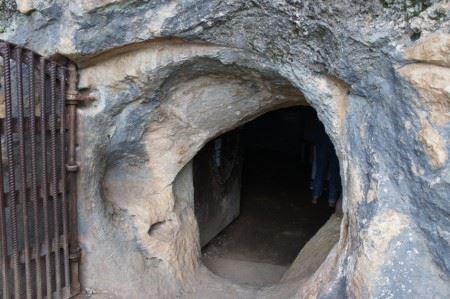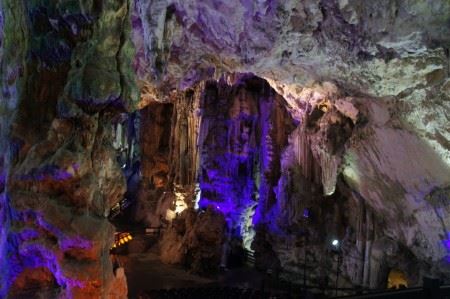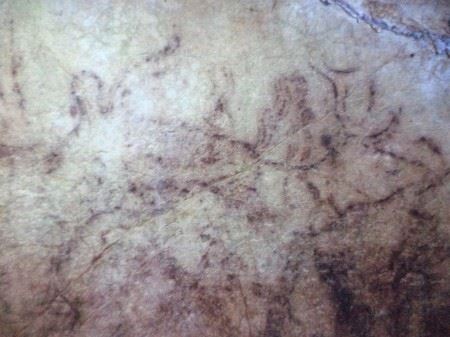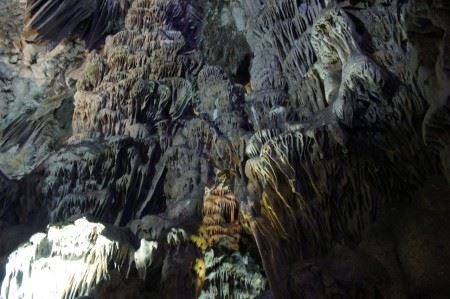 Present day entrance, discovered in 1924
Present day entrance, discovered in 1924
I simply cannot fathom why some people love to repel themselves hundreds of meters into caves and squeeze themselves through even darker cracks into airless underground chambers. Yet, somehow, I found myself voluntary locked into an unlit cave amongst million-year-old stalagmites and petrified human remains, and loving it! Meet La queva de la Pileta:
In 1905, an Andalucían sheep farmer called José Bullón Lobato noticed a swarm of bats flying around a mountainside. Since bat droppings are good fertilizers he climbed up locate the source, hoping to use the droppings for his olive trees. He found an opening in the mountain with a deep chasm. Returning with rope and a torch, he let himself down to discover an enormous cave with mysterious markings on the walls. He guessed that these were the work of the Moors, some 800 years back. He was off by over 20.000 years!
 The discovery of La Cueva de la Pileta (the Cave of the Pond) changed the lives of his family. They bought the land where the cave was located and started studying the cave paintings together with international scientists. In 1924, the cave became a Spanish national monument, though still owned and cared for by the family. Only in the last decades has it been open to the general public. While the first scientist accessed the area on horseback, today it is considerably easier. The cave is located about 30 minutes drive from Ronda and we brought a willing visitor along. From the parking lot, we climbed the 101 stone steps leading to the cave entrance. (Thankfully the family discovered this second entrance in 1924, so we needed neither rope nor repelling gear.)
The discovery of La Cueva de la Pileta (the Cave of the Pond) changed the lives of his family. They bought the land where the cave was located and started studying the cave paintings together with international scientists. In 1924, the cave became a Spanish national monument, though still owned and cared for by the family. Only in the last decades has it been open to the general public. While the first scientist accessed the area on horseback, today it is considerably easier. The cave is located about 30 minutes drive from Ronda and we brought a willing visitor along. From the parking lot, we climbed the 101 stone steps leading to the cave entrance. (Thankfully the family discovered this second entrance in 1924, so we needed neither rope nor repelling gear.)
For those who search for authentic nature experiences, La Pilta is completely undeveloped. There is no gift shop and no set tour-schedule. Our guide, the grandchild of the discoverer, is the fourth generation to care for the cave, a legacy he does not take lightly. He waited until a group of about a dozen people had gathered, then unlocked a heavy padlock and opened the double door with steel bars covering the entrance. By muted torchlight he collected the entrance fees. Since the cave has no electric lighting, he handed every couple of visitors a small portable lamp. Then he locked the gate behind us, to assure that nobody could enter, or exit for that matter…
 He informed us of the strict rules to minimize the impact of visitors in this sensitive environment. No loud sounds, no touching walls or geological formations, and absolutely no cameras or videos, all of which can deteriorate the cave paintings and stone formations that have taken millennia to form. It may also dstroy or altr a very sntitive eco systm within the cave, containing some water beetle species that are found nowhere else on this planet. Electric light, he told us, bleaches the natural mineral deposits that give the amazing variety of colours to the cave walls. (In the floodlit theme-park-style caves of Gibraltar or Nerja near the coast, one can see examples of this deterioration) As we accustomed ourselves to moving in semi-darkness, an amazing underground world lay before us. La Pileta is truly a living cave. We heard trickles of water everywhere. And the flurry of bat wings. The cave is the home to 18 000 bats, though not the Dracula blood sucking type, we were assured. Besides, at the time of our visit most of them were at work, catching other tasty morsels.
He informed us of the strict rules to minimize the impact of visitors in this sensitive environment. No loud sounds, no touching walls or geological formations, and absolutely no cameras or videos, all of which can deteriorate the cave paintings and stone formations that have taken millennia to form. It may also dstroy or altr a very sntitive eco systm within the cave, containing some water beetle species that are found nowhere else on this planet. Electric light, he told us, bleaches the natural mineral deposits that give the amazing variety of colours to the cave walls. (In the floodlit theme-park-style caves of Gibraltar or Nerja near the coast, one can see examples of this deterioration) As we accustomed ourselves to moving in semi-darkness, an amazing underground world lay before us. La Pileta is truly a living cave. We heard trickles of water everywhere. And the flurry of bat wings. The cave is the home to 18 000 bats, though not the Dracula blood sucking type, we were assured. Besides, at the time of our visit most of them were at work, catching other tasty morsels.
In the first ‘gallery’, a natural chimney was used as an enormous hearth during the Bronze Age. Further into the cave we would see soot deposits from smaller fires, as there was natural ventilation there. Moving along the slippery ground, I felt as if we were walking on a petrified composite of human remains. And we probably were. Both Paleolithic and Neolithic Man occupied this cave for long periods of time. Fragments of pottery have been found, as well as several skeletons. Amongst these was a stout and muscular man of the early Neolithic European race. La Pileta was thus one of the places where the first Homo sapiens sapiens made their home after crossing over from Africa. The Carbon 14 testing can only test back 32 000 years, but newer scientific equipment can go further back and date the finds more accuratly.
Not only did the cave dwellers live there. Our prehistoric relatives also made amazing art from clay, minerals and animal fat. 134 paintings, black, ochre and red, have been found, some five times older than the Egyptian pyramids and many quite inaccessible, even now. How did our ancestors manage this?
 I was surprised that the 20 - 32.000 year old drawings were more naturalistic and seemed ‘better’ than the newer charcoal drawings dating back ‘only’ 4 - 8000 years. The older drawings made by Cro-Magnon Man in the upper Paleolithic period, showed horses, goats and bison, often to perfect scale. There was even a giant reindeer, which meant that people found shelter here during at least one ice age. The Neolithic drawings, said to be of the Levantine school, were mostly lines (counting winters stuck in the cave?), zigzag patterns and stick men of more symbolic natire. Some looked like Robinson Crusoe style primitive calendars.
I was surprised that the 20 - 32.000 year old drawings were more naturalistic and seemed ‘better’ than the newer charcoal drawings dating back ‘only’ 4 - 8000 years. The older drawings made by Cro-Magnon Man in the upper Paleolithic period, showed horses, goats and bison, often to perfect scale. There was even a giant reindeer, which meant that people found shelter here during at least one ice age. The Neolithic drawings, said to be of the Levantine school, were mostly lines (counting winters stuck in the cave?), zigzag patterns and stick men of more symbolic natire. Some looked like Robinson Crusoe style primitive calendars.
The change from figurative to abstract art indicates that form and fashion altered through these millennia. In fact, the Late Old Stone Age art of Andalucía is very similar to
that found in southwestern France and northern Spain. Does this mean that there were traveling art teachers back then?
We continued up and down along 243 slimy steps, carved into the ground in the 1920’s. In the narrowest passages, the larger members of our group had to squeeze though with only millimeters to spare and duck to avoid stalactites. We passed by a couple of shallow underground pools, or piletas. Our guide explained that the cave system was originally an underground river dug out of the limestone. In dry periods stalactites and stalagmites formed, while in wet periods the cave was flooded with water, explaining why some of the walls have been worn smooth. Some visitors seemed to worry about a sudden flash flood. After all, we were locked into the mountain with only a few measly lamps between us. Our guide smiled, “Maybe not today…”
 Up close we could see tiny droplets carrying microbes of limestone attaching themselves to the bottom of stalactites, eventually falling and forming a stalagmite below. It takes about a century for a stalagmite to grow a mere milimeter – that is unless the drop comes down too quickly, eroding instead of adding to it. We were told the names of some of the rock formations, but I was too busy trying to stay on my feet and lighting the way for an almost legally blind co-visitor to take much note.
Up close we could see tiny droplets carrying microbes of limestone attaching themselves to the bottom of stalactites, eventually falling and forming a stalagmite below. It takes about a century for a stalagmite to grow a mere milimeter – that is unless the drop comes down too quickly, eroding instead of adding to it. We were told the names of some of the rock formations, but I was too busy trying to stay on my feet and lighting the way for an almost legally blind co-visitor to take much note.
Our walk ended 500 meters into the mountain in a hall with a 50-meter-high ceiling and a 20,000 year-old drawing of a fish on the wall. Our guide stomped on floor and the sound reverberated underneath us. Wasn’t that the ground that moved? He told us that there was a larger yet hall right underneath us, and the layer between the two halls was only four meters thick, creating a disturbingly realistic echo. The group eyed each other with looks of ‘Let’s get out of here!’
We had hardly walked a fraction of the explored caves, only what now is accessible and considered safe – not safe for the general public, but for the cave paintings and geological formations. Back outside, after buying a couple of post cards by candle light, I could honestly say that it had been thrilling and that this would not be my last cave. It was a true privilege to be taken on a journey of 30.000 years of prehistoric art, even more so when it was guided by a family-member of the man who re-discovered the cave a century ago.
The province of Cádiz alone has several hundred unexplored caves with paintings, most of which have been closed up by the government. La Cueva de La Pileta is the only National Monument cave in Spain that is under private ownership. For decades, the government has tried to take it over. The Bullón Lobato family has guarded La Pileta with outmost care for four generations, assuring that the sensitive environment is not damaged. Thanks to strong support from both geological and archeological specialists from around the world, the family is still the owner and caretaker of the cave. For for information, go to www.cuevadelapileta.org
Note: The Pileta photos on this blog post are from postcards or from the entranc of the cave. The interior cave photos were taken at the cave in Gibraltar where photographing is allowed.

A 4-meter-long, 20.000 year-old cave drawing. Note the contour of a perfect seal in its perimeters.